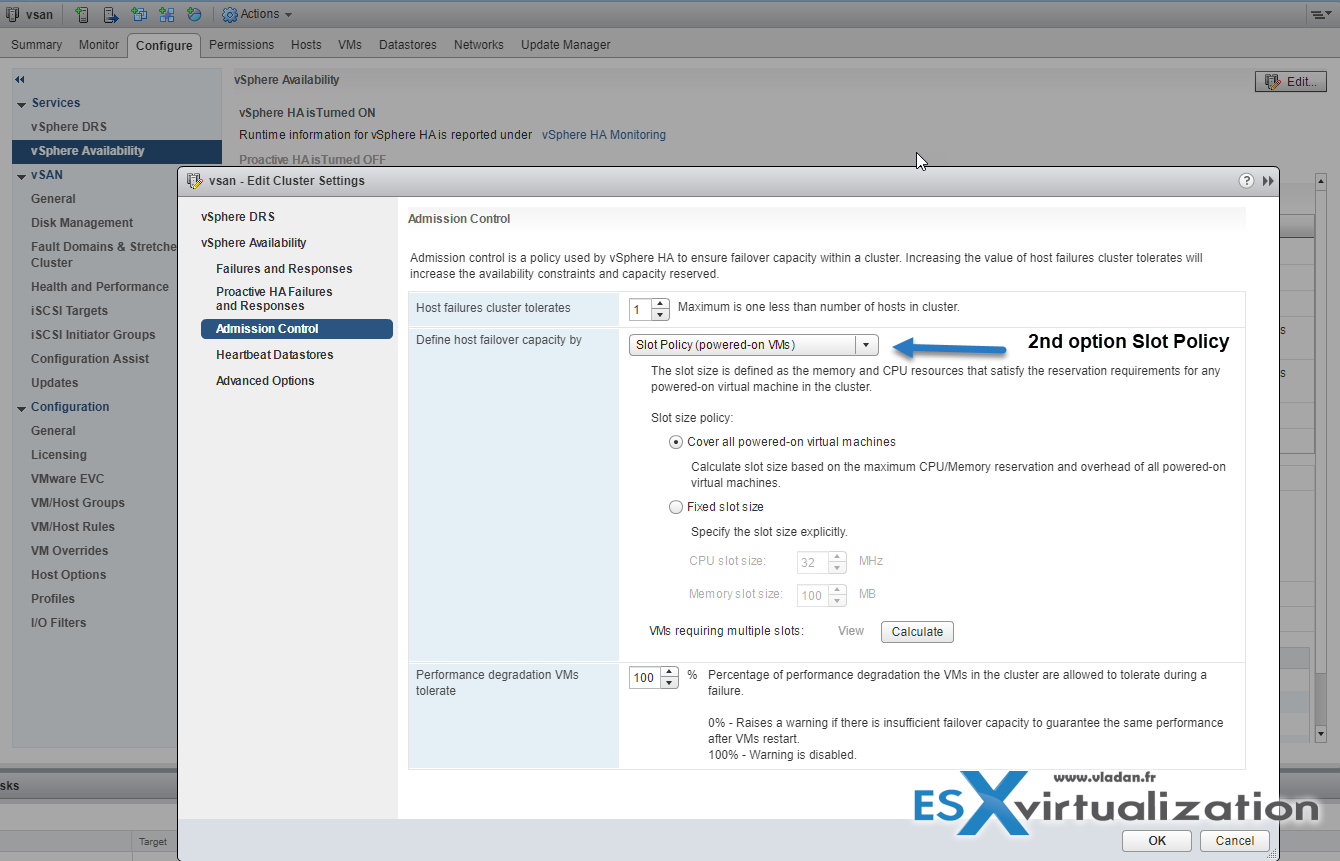Vmware Slot Size Policy
After you create a cluster, you can configure admission control to specify whether virtual machines can be started if they violate availability constraints. The cluster reserves resources so that failover can occur for all running virtual machines on the specified number of hosts.

VMware vSphere HA Admission Control – Slot Policy This is the first option from the top, within the drop-down menu. In this case, the default is to “cover all powered-on VMs” and basically, it calculates the slot size based on the maximum CPU/Memory reservation and overhead of all powered-on VMs.

Vmware Slot Size Policy Guide
If you have the VM configured with the highest memory reservation of 8192 MB (8 GB) and highest CPU reservation of 4096 MHZ. Among the other VM’s in the cluster, then the slot size for memory is 8192 MB and slot size for CPU is 4096 MHZ. Vmware Ha Slot Size only then will Vmware Ha Slot Size you be able to cash out winnings from the bonus. The rules matter: It is important to be aware of the rules associated Vmware Ha Slot Size with the bonus to be able to use it properly. The most common of these apart from the wagering requirement is the list of eligible games for the bonus. Learn what a slot is, how it is calculated, and how it affects your vSphere HA Admission Control. As hopefully all of you know by now, the percentage based admission control policy does not work with fixed slot sizes. (More details to be found in the Availability Guide and the Best Practices white paper.)The percentage based admission control policy is a per virtual machine mechanism, hence the reason I always prefer this admission control.
The Admission Control page appears only if you enabled vSphere HA.
Vmware Slot Size Policy Tool

Procedure
- In the vSphere Client, browse to the vSphere HA cluster.
- Click the Configure tab.
- Select vSphere Availability and click Edit.
- Click Admission Control to display the configuration options.
- Select a number for the Host failures cluster tolerates. This is the maximum number of host failures that the cluster can recover from or guarantees failover for.
- Select an option for Define host failover capacity by. Option
Description Cluster resource percentage Specify a percentage of the cluster’s CPU and memory resources to reserve as spare capacity to support failovers. Slot Policy (powered-on VMs) Select a slot size policy that covers all powered on VMs or is a fixed size. You can also calculate how many VMs require multiple slots. Dedicated failover hosts Select hosts to use for failover actions. Failovers can still occur on other hosts in the cluster if a default failover host does not have enough resources. Disabled Select this option to disable admission control and allow virtual machine power ons that violate availability constraints. - Set the percentage for the Performance degradation VMs tolerate. This setting determines what percentage of performance degradation the VMs in the cluster are allowed to tolerate during a failure.
- Click OK.
Your admission control settings take effect.
You might get a not enough failover resources fault when trying to power on a virtual machine in a vSphere HA cluster.
If you select the Host Failures Cluster Tolerates admission control policy and certain problems arise, you might be prevented from powering on a virtual machine due to insufficient resources.
Cause
This problem can have several causes.- Hosts in the cluster are disconnected, in maintenance mode, not responding, or have a vSphere HA error.
Disconnected and maintenance mode hosts are typically caused by user action. Unresponsive or error-possessing hosts usually result from a more serious problem, for example, hosts or agents have failed or a networking problem exists).
- Cluster contains virtual machines that have much larger memory or CPU reservations than the others.
The Host Failures Cluster Tolerates admission control policy is based on the calculation on a slot size comprised of two components, the CPU and memory reservations of a virtual machine. If the calculation of this slot size is skewed by outlier virtual machines, the admission control policy can become too restrictive and result in the inability to power on virtual machines.
- No free slots in the cluster.
Problems occur if there are no free slots in the cluster or if powering on a virtual machine causes the slot size to increase because it has a larger reservation than existing virtual machines. In either case, you should use the vSphere HA advanced options to reduce the slot size, use a different admission control policy, or modify the policy to tolerate fewer host failures.
Vmware Slot Size Policy Chart
View the Advanced Runtime Info pane that appears in the vSphere HA section of the cluster's Monitor tab in the vSphere Web Client. This information pane shows the slot size and how many available slots there are in the cluster. If the slot size appears too high, click on the Resource Allocation tab of the cluster and sort the virtual machines by reservation to determine which have the largest CPU and memory reservations. If there are outlier virtual machines with much higher reservations than the others, consider using a different vSphere HA admission control policy (such as the Percentage of Cluster Resources Reserved admission control policy) or use the vSphere HA advanced options to place an absolute cap on the slot size. Both of these options, however, increase the risk of resource fragmentation.